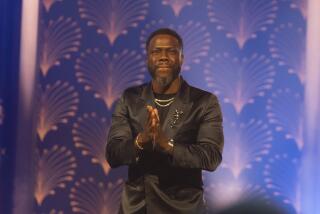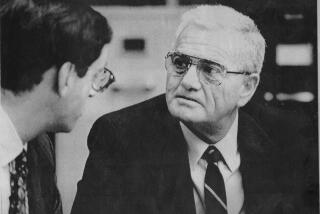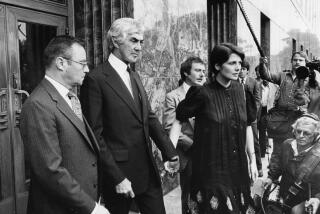THE O.J. SIMPSON MURDER TRIAL : Excerpts of Opening Remarks by Defense Counsel Cochran
Excerpts of opening statement Monday by defense counsel Johnnie L. Cochran Jr. in the O.J. Simpson double-murder trial.
As you’ll recall from our discussion last week, in discussing the evidence we talked about the coroner’s office and talked about what we expect the evidence to show regarding their shortfalls. We’ve sought to reply to the things that have been brought up by the two prosecutors in their opening statements. And I believe that at the end of the day we had reached the point where I told you we were about to discuss the Los Angeles Police Department and their handling of this matter. In the course of our discussion today, we will be talking about the evidence which was seized or collected at the scene of Bundy and also at Rockingham. . . .
Under this scenario, we expect to be talking about the integrity of the evidence; that is, whether or not this evidence is capable of your belief, whether or not it’s evidence that is correct and appropriate, how was it collected. . . .
All the evidence picked up at the Nicole Brown Simpson condo, at the top the evidence picked up at the Simpson home on Rockingham, the evidence from the Bronco, any blood, all went first through the LAPD there, and then ultimately from LAPD it was sent out to the various labs, be it the FBI, Cellmark or the Department of Justice. . . . We expect the evidence will show that this evidence that was collected at these various locations that you’ve just seen was contaminated, compromised and ultimately corrupted. . . .
Now, briefly last week I spoke to you about a detective named Mark Fuhrman. Mr. Fuhrman and his partner, Mr. (Ronald) Phillips, worked West Los Angeles homicide. . . . and they were the first ones to arrive at the (Bundy Drive crime) scene.
Although you didn’t hear about Mr. Fuhrman in the course of the opening statement of the prosecution, we think he’ll be a key witness in this case. . . . The evidence will show the bodies were found around 12:15 on June 13, 1994; that after arriving at the scene Mr. Fuhrman did a number of things, you saw him in one of the pictures last week where he was pointing down at the--allegedly the glove and the cap that was under some shrubbery. If you recall, that was a picture of Mr. Fuhrman at that point. You notice that he had--his shoes were not covered, that he had walked in that location at that point without shoes being covered, that he made a number of discoveries at that particular point. . . .
We have now for you some video relating to Detective Mark Fuhrman, and I’d like for you to listen to what he has to say with regard to the glove. Now, in fairness to Detective Fuhrman, the question he’s been asked is about the glove, and they talk about the glove. But in his response, as you’ll see, he at some point talks about seeing them at the foot of Mr. Goldman. . . . And the question we’ll be seeking to establish in this trial, (Fuhrman) saw them down at the feet, was he talking about two gloves at that point?
We think the evidence will show that (the Bundy Drive crime) scene was tracked and traipsed up, and the gathering of the evidence was a complete disaster, and we feel that the evidence will be shown to be contaminated, compromised and corrupted, as we indicated earlier. . . .
Nowhere, I think, will you find in this case is the problem of the evidence being contaminated, compromised and corrupted, more important than the error of DNA testing. . . . The evidence will show (DNA testing) is a very new and powerful technology. In the past five years, police departments and crime labs have tried to transfer this DNA test that has been used for research and medical diagnosis and apply it to crime scene samples. We expect you will hear in the course of the evidence this transfer of technology has not been simple or easy.
And so I want to share with you in the course of my opening statement now some differences between DNA testing for medical purposes and forensic DNA testing on crime scene samples. Remembering . . . that all evidence passes through first the LAPD’s hands. If it’s compromised when it starts, it’s compromised when it starts. If the evidence was contaminated at the scene or mishandled by the Los Angeles Police Department, it doesn’t matter what DNA tests are done afterward, how many times they are done or which laboratories did them, the results will not be reliable and we expect the evidence will show. . . .
This is, as I indicated to you last week, cyberspace, or 21st-Century technology, and I think you will find the evidence will be that the collection procedures are 19th-Century, covered-wagon collection procedures, and that’s why it’s such a problem. And so if you looked at this medical research area, and generally you could expect that in the medical field that there are clean samples more than likely in a clean medical lab. . . .
Contrary, as I said, to what the prosecutor told you last week, the evidence will be it’s not as simple as wiping up a spill. This technology is so sensitive. It’s not that, that simple at all. You and I just shouldn’t go out and do this. We can do it if we want to use the same techniques we were using with the LAPD, but you’ll get results that are all unreliable.
We expect during the course of our evidence in this case to show that from their own studies, the LAPD’s laboratory is a cesspool of contamination, looking at their own records and the tests they have run, we’ll demonstrate for you what those records show.
We expect then in this entire area that the evidence will show that the careless, slipshod, negligent collection, handling and processing of samples by basically poorly trained personnel from LAPD has contaminated, compromised and corrupted the DNA evidence from this case.
I n summary, as you then look at all the evidence in this case, we expect the evidence will show that O.J. Simpson as you see him there is not a perfect human being, like all of us has made mistakes. . . .
We think the evidence will show he’s not guilty of these horrible crimes. He has been blessed bountifully by God, shared his largess with many, many people. In this instance, the prosecutor’s theory that there’s only one murderer is just theory. We expect to show evidence that there was more than one killer, that the prosecutor’s theory will be overcome by the facts which we will present.
We also expect that the evidence will show that the reason the prosecution maintains there’s only one killer is that Mr. Simpson, who they want to portray as a stalker, and stalkers don’t come in pairs. . . . And that’s why they’re wedded to this one murderer, even contrary to what their own coroner may very well indicate.
I’ve shared with you also the fact of Mr. Goldman’s journey that evening and when he checked out and went home and changed clothes and everything, so I will not belabor that. We expect there will be evidence about how you get into 875 South Bundy, when one comes up, rings the bell or whatever, how you get in from the house, whether that’s possible, whether somebody has to let you in or how you get into the particular residence. I’ve already told you we expect there will be evidence of the size of this area. (Deputy Dist. Atty. Marcia) Clark had indicated, and I think the evidence will show, this is a very, very small area, given the circumstances.
We will show that the police who came over to Bundy, who you seen walking through that scene, went in that house and didn’t take one picture. They went in the house (and) . . . they found candles burning and various other things, the investigation inside that house was shoddy and scarce, if at all, under the circumstances. . . .
You’ll recall that we talked to you a lot about truth and your common sense. During voir dire, I think all of us told you that we wanted you to use your collective common sense and don’t leave it outside in the hallway, to bring it in and apply it to the facts of this particular case. And in applying that common sense, as I indicated to you, you looked and you’ll be able to see this small area. You’ll see the fight that Mr. Goldman put up. You’ll see the injuries that he sustained. You’ll hear the testimony about the amount of blood to be expected on the perpetrator. You’ve seen Mr. Simpson’s body, the lack of scratches thereof. You’ll see and your common sense will address based upon the evidence the issue of whether one person could kill two people under these circumstances without hearing screaming and a lot of running and all sort of things. We expect, hopefully, that the evidence presented by the defense will help you provide some answers to these common sense questions.
We expect also that you’ll hear from a witness by the name of Paula Barbieri. Both sides are aware and will testify about her relationship with Mr. O.J. Simpson. Specifically, as I mentioned earlier, between the period May of 1992 and May of 1993, and May of 1994 to the present.
This case really boils down to a whodunit; that’s what this case is about. It’s not about domestic violence or whatever. It’s about who killed these two people in these particular horrible crimes. The prosecution will possibly start off with the domestic discord evidence. And that with all the evidence, we ask that you keep an open mind. You know the circumstances. You know there are generally two sides to every situation. We cannot call our witnesses until . . . it’s our part of the case to put these witnesses on. That’s why I spent so much time in this part of the opening statement when we try to detail what we expect the evidence to be and what we expect the evidence to show.
I started off indicating that I thought this case would be a case that we would establish a rush to judgment by the prosecution and they have theory and speculation, and we would have the facts.
Clark: Objection.
Judge Lance Ito: I assume these are the concluding remarks?
Cochran: Yes, your Honor.
Ito: Thank you.
Cochran: They would have theories and speculation, and we would have the facts.
Clark: Objection (Inaudible).
Cochran: She’s trying to preclude what I’m saying. . . . In this instance, in this case, both sides are interested in the search for truth. That’s what a trial really is. It’s a journey for truth. For you to determine the true facts of what happened June 12th, 1994. We spent a great amount of time in selecting each of you for this task because we knew it would be a very significant task. . . .
God knows what happened on June 12th, 1994, and we hope that after you have heard all the evidence in this case, you can make a rational decision in this case, and you too will know what happened. And you will know that O.J. Simpson . . .
Clark: Objection, your Honor.
Ito: He can say that’s what he intends to prove. Counsel, he can say that.
Cochran: Thank you. You will know that the evidence will show that O.J. Simpson, that man pictured over there, on June 12th did not kill his wife, did not kill Ron Goldman, and he is entitled to an acquittal. Thank you very much for your attention. This may be the longest opening statement in the history of this building. And I appreciate your patience and the fact that you took the time to listen. Thank you.
These excerpts are abridged from transcripts of court proceedings provided by Westlaw research service.
More to Read
Sign up for Essential California
The most important California stories and recommendations in your inbox every morning.
You may occasionally receive promotional content from the Los Angeles Times.










